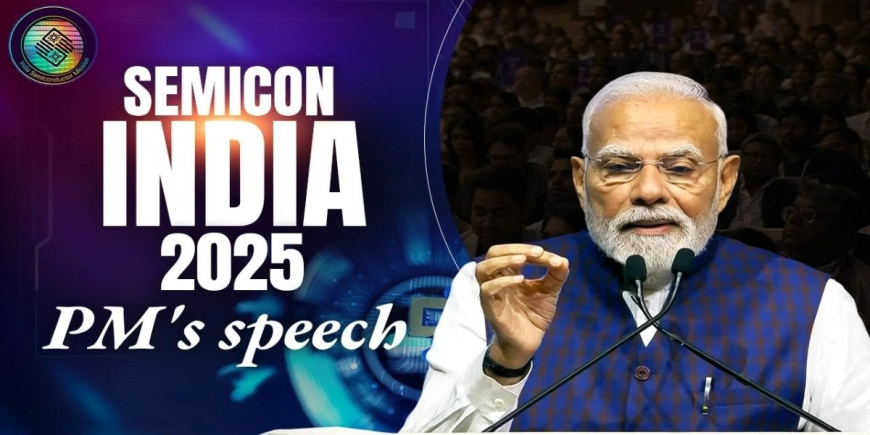India Semiconductor Future Unveiled: PM Modi's Vision for a Trillion-Dollar Digital Economy
Breaking: PM Modi outlines India's rapid stride towards becoming a global semiconductor hub, attracting $18 billion in investments and aiming for a significant share of the $1 trillion market. Discover India's tech future.

By: Neeraj Ahlawat | Date:Sep 02, 2025
Breaking news from Yashobhoomi, Delhi! Prime Minister Narendra Modi has articulated a bold vision for India's semiconductor industry at Semicon India 2025, declaring chips as the "digital diamonds" of the 21st century. This pivotal address signals India's intent to capture a substantial share of the burgeoning $1 trillion global semiconductor market, positioning the nation as a key player in shaping the technological future.
"Digital Diamonds": India's Trillion-Dollar Semiconductor Ambition
Addressing a gathering of global semiconductor experts from over 40-50 countries, industry CEOs, and young innovators at Semicon India 2025, Prime Minister Narendra Modi emphasized India's unique position as a trusted and capable partner for building the semiconductor future. Fresh from visits to Japan and China, where he explored advanced technology facilities, the Prime Minister highlighted his personal passion for technology and expressed his delight at engaging with the industry.
PM Modi underscored India's robust economic performance, citing a remarkable 7.8% GDP growth in the first quarter of the year, a period when many global economies face significant concerns. This growth, observed across manufacturing, services, agriculture, and construction, instills new energy across industries and among citizens, firmly setting India on a path to become the world's third-largest economy. The Prime Minister drew a compelling analogy, stating that while oil shaped the 20th century, the "digital diamonds" of tiny chips will define the 21st century's progress. He noted that the global semiconductor market, currently valued at $600 billion, is projected to surpass $1 trillion in the coming years, and India is poised to secure a significant share of this expanding market.
Accelerated Progress: From Program Launch to Production
Highlighting the rapid pace of India's semiconductor journey, PM Modi detailed the swift progression from policy inception to practical implementation. The Semicon India Program, launched in 2021, saw India's first semiconductor plant approved by 2023. This momentum continued with additional plant approvals in 2024 and the clearance of five more projects in 2025. In total, India has approved 10 semiconductor projects, attracting an investment exceeding $18 billion (over 1.5 lakh crore Indian Rupees), a clear testament to the growing global confidence in the nation.
The Prime Minister proudly announced that pilot plants are already operational, with CG Power's facility commencing operations on August 28th, just days before his speech. Test chips are already being produced by Micron and Tata, and commercial chips are anticipated to roll out within this year. This swift progress, from program launch to the start of production within a few years, demonstrates India's accelerated trajectory in the semiconductor sector.
Government-Driven Ecosystem: Fostering Innovation and Infrastructure
The Indian government's approach prioritizes speed and efficiency, striving to reduce the time from "file to factory" by minimizing paperwork. To this end, the National Single Window System has been implemented, consolidating all central and state approvals onto a single platform, thereby liberating investors from extensive bureaucratic processes.
Furthermore, India is actively developing "plug and play" infrastructure models, establishing semiconductor parks nationwide. These parks are designed to offer comprehensive facilities, including land, reliable power supply, connectivity to ports and airports, and access to a skilled workforce. Coupled with various incentives such as PLI (Production-Linked Incentive) schemes and Design-Linked Grants, these initiatives create a conducive environment for industrial growth. India is committed to offering end-to-end capabilities, signaling its transformation from a "back-end" support system to a "full-stack semiconductor nation". The vision is clear: India's smallest chip will drive the world's biggest changes.
Beyond Manufacturing: Cultivating a Full-Stack Semiconductor Nation
India's semiconductor success story is not confined to a single technology or vertical; instead, it encompasses the creation of a comprehensive ecosystem. This ecosystem integrates designing, manufacturing, packaging, and high-tech device development, all within India. The Semiconductor Mission extends beyond merely establishing a fab or chip manufacturing unit; it aims to build an ecosystem that fosters self-reliance and global competitiveness for India.
A key focus of India's mission is to advance with the world's most sophisticated technologies, ensuring that chips manufactured in India power emerging technological innovations. Design centers in Noida and Bengaluru are actively engaged in developing highly advanced chips that incorporate billions of transistors, poised to energize 21st-century immersive technologies. Acknowledging global challenges in the sector, India is also proactively addressing critical mineral requirements. Recognizing that critical minerals form the foundation of digital infrastructure, much like steel supports physical infrastructure, India is pursuing a National Critical Mineral Mission to fulfill its domestic demand for rare minerals. Significant progress has been made on critical mineral projects over the past four years.
Empowering the Future: Role of Startups, MSMEs, and States
PM Modi emphasized the crucial role of startups and MSMEs in driving the growth of the semiconductor sector. India currently contributes an impressive 20% of the world's semiconductor design talent, positioning its youth as a significant "human capital factory" for the industry. The government actively encourages young entrepreneurs, innovators, and startups to come forward, offering schemes like the Design Linked Incentive Scheme and the Chips to Startup Program. The Design Linked Incentive Scheme is even undergoing an upgrade to better support the industry.
A core objective is to cultivate Indian Intellectual Property (IP) within this sector, with support also coming from the recently launched National Research Fund (Anusandhan). Furthermore, numerous Indian states are actively participating, crafting special policies for the semiconductor sector and investing in dedicated infrastructure. The Prime Minister called for a "healthy competition" among states to develop their semiconductor ecosystems and attract investment, fostering a nationwide growth environment.
A Global Invitation: India's Long-Term Commitment to Tech Leadership
Underpinning its progress, India operates on the mantra of "Reform, Perform, and Transform". The nation is now preparing to embark on the next phase of "Next Generation Reforms" and is actively working on the subsequent phase of the India Semiconductor Mission. PM Modi extended an open invitation to global investors, assuring them of a warm welcome and long-term commitment. In the language of the industry, he stated that "design is ready, masks aligned, now it's time to execute with precision and deliver at scale".
He stressed that India's policies are not short-term signals but long-term commitments, promising to meet the needs of investors. The Prime Minister expressed confidence that soon, the world will acknowledge products that are "Design in India, Made in India, Trusted by the World". He concluded by wishing for every "bit" of effort to be successful, every "byte" to be filled with innovation, and India's journey to be "error-free and high-performance".
FAQs
1. What is India's vision for the semiconductor industry? India envisions becoming a "full-stack semiconductor nation," self-reliant and globally competitive. The goal is to develop an entire ecosystem covering designing, manufacturing, packaging, and high-tech device creation, with Indian-made chips powering emerging global technologies.
2. How much investment is India attracting in the semiconductor sector? India has approved 10 semiconductor projects with a total investment exceeding $18 billion (over 1.5 lakh crore Indian Rupees). This significant investment reflects growing global trust and confidence in India's potential as a semiconductor hub.
3. What government initiatives support semiconductor growth in India? The government has implemented a National Single Window System for approvals, established "plug and play" semiconductor parks, and offers incentives like PLI schemes and Design-Linked Grants. These measures streamline processes and provide robust infrastructure.
4. How are startups contributing to India's semiconductor mission? Startups and MSMEs are crucial, leveraging India's 20% global share in semiconductor design talent. Government schemes like the Design Linked Incentive Scheme and Chips to Startup Program, along with support from the National Research Fund, foster their innovation and intellectual property development.
5. When are commercial chips expected from India? Pilot plants, such as CG Power's, have already started operations. Test chips from Micron and Tata are being produced, and commercial chips are anticipated to begin rolling out from India within the current year, marking a significant milestone.










































